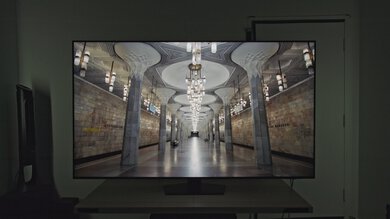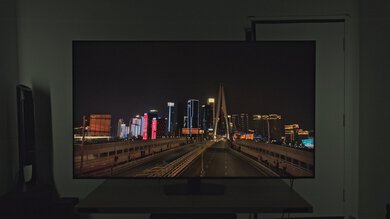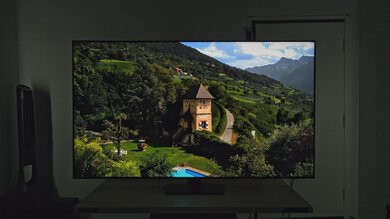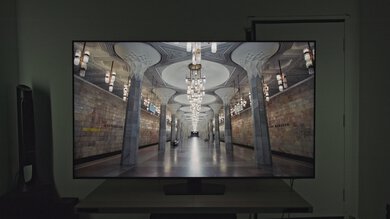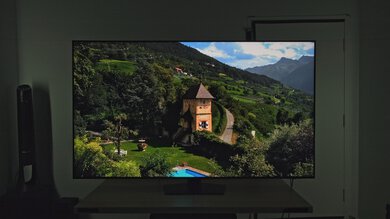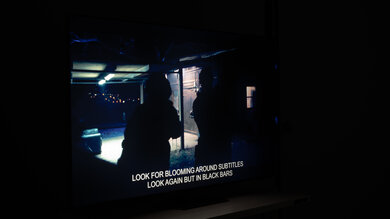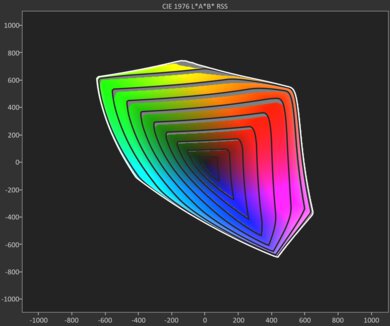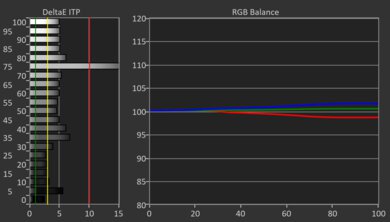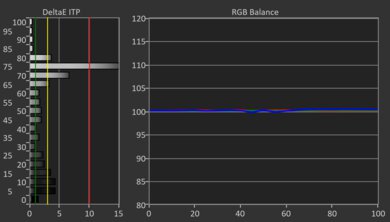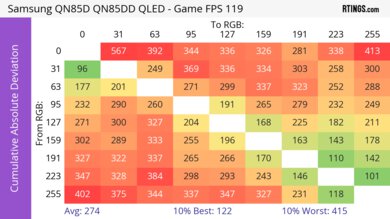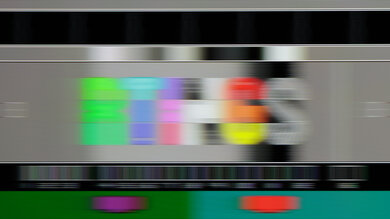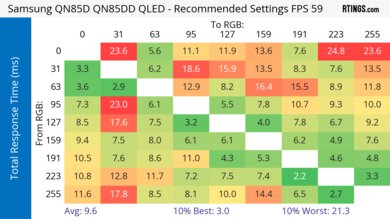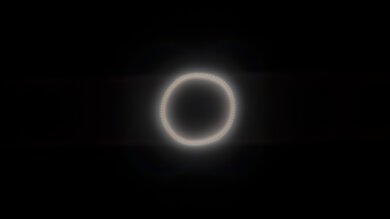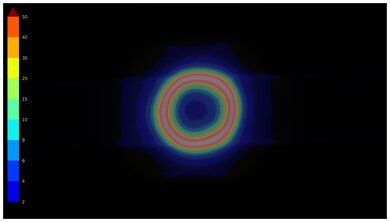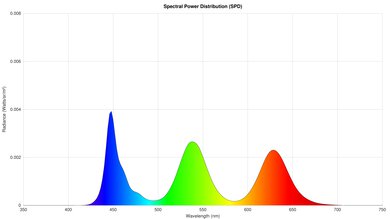The Samsung QN85D succeeds the Samsung QN85C and is Samsung's lowest Neo QLED offering in 2024, sitting below the Samsung QN90D/QN90DD QLED and the Samsung QN95D. It features a Mini LED backlight, allowing for high levels of brightness and fine control over the TV's local dimming zones. It carries Samsung's Auto HDR Remastering technology, which uses AI to convert SDR content to the HDR color space. It also has an integrated microphone on both the TV and the remote, allowing for hands-free voice control through Bixby or Amazon's Alexa. It comes with Samsung's 2024 NQ4 AI Gen2 Processor, which powers the TV's image processing capabilities, as well as its Dolby Atmos sound processing. It's a fully featured gaming TV with four HDMI 2.1 bandwidth ports for up to 4k @ 120Hz gaming and support for every variable refresh rate (VRR) technology. We bought and tested the 65-inch model, but it also comes in 55, 75, and 85-inch sizes.
Our Verdict
The Samsung QN85D is good for mixed usage. It's good in reference conditions thanks to its fairly deep blacks and vibrant colors, and turning your lights on barely impacts those, which is great. Furthermore, it has more than enough SDR brightness to fight glare, but it does struggle with direct reflections. HDR content has impactful highlights, but it's dimmer when using Game Mode, meaning you have to trade in brightness for the best performance. Still, it's a decent option for gamers due to its modern gaming features, but its slow pixel transitions means motion lacks sharpness. Its viewing angle is good enough for a consistent image from a slight angle, but it worsens quickly from aggressive angles, limiting its usefulness in large living rooms.
-
Good HDR brightness for impactful highlights.
-
Excellent SDR brightness means it overcomes glare from indirect lighting.
-
Good color vibrancy in HDR.
-
Slow pixel transitions in Game Mode leads to blurry motion.
-
Direct reflections are very visible on the screen.
The Samsung QN85D is good for a home theater. The TV has good HDR brightness and decent enough black levels for highlights to stand out well against darker backgrounds. The brightness of HDR content has excellent accuracy, staying true to the filmmaker's intent. Although colors lack some brightness, they're still vibrant enough to stand out in most content. It has good upscaling capabilities to help low-resolution content look sharp enough, but its low-quality content smoothing isn't good enough to completely eliminate artifacts in heavily compressed content. The TV doesn't have too much stutter in low frame rate content, and most people won't notice it. Unfortunately, it doesn't support Dolby Vision or DTS audio passthrough, which is a downside for those with a physical media collection.
-
Good HDR brightness for impactful highlights.
-
Good upscaling capabilities.
-
Excellent PQ EOTF tracking for accurate brightness in HDR content.
-
Good color vibrancy in HDR.
-
Good lighting zone precision keeps blooming to a minimum.
-
Low-quality content smoothing is okay, but noticeable artifacts are still present.
-
Doesn't support Dolby Vision and DTS.
The Samsung QN85D is very good for a bright room. It has amazing SDR brightness, so it overcomes glare from indirect lighting with ease. Unfortunately, it has inadequate direct reflection handling, so it's not a good option if you have lamps, windows, or other light sources directly opposite the screen. Fortunately, the TV maintains deep blacks and its color vibrancy in a bright room, so picture quality remains mostly unaffected by light.
-
Excellent SDR brightness means it overcomes glare from indirect lighting.
-
Blacks remain deep and colors barely lose saturation in a bright room.
-
Direct reflections are very visible on the screen.
The Samsung QN85D is very good for watching sports. Its amazing SDR brightness lets it easily overcome glare from indirect lighting. However, its direct reflection handling is inadequate if you have any lights placed opposite the screen since they're very visible on the screen. The TV has true-to-life colors, motion is smooth, and it does a good job of upscaling. All of this leads to a mostly pleasant viewing experience. Unfortunately, there's some dirty screen effect towards the center of the screen, and the TV doesn't eliminate artifacts very well from compressed feeds, so the image isn't entirely clean-looking. The TV's viewing angle is wide enough if you have friends watching from a slight angle and want them to see a mostly consistent image, but it's not quite wide enough for wide seating arrangements.
-
Good upscaling capabilities.
-
Excellent SDR brightness means it overcomes glare from indirect lighting.
-
Excellent SDR pre-calibration color accuracy.
-
Some noticeable dirty screen effect towards the center of the screen.
-
Direct reflections are very visible on the screen.
-
Low-quality content smoothing is okay, but noticeable artifacts are still present.
The Samsung QN85D is just decent for gaming. It supports HDMI 2.1 bandwidth for 4k @ 120Hz with VRR and has low input lag. Unfortunately, it's held back by its slow pixel transitions; this isn't the TV to get if you want crystal-clear motion. In terms of picture quality, it's decent overall, with deep blacks and colors that are vivid enough for most people. Unfortunately, it's dimmer in HDR when using Game Mode than it is in the other picture modes, so you have to trade in some brightness for the best possible gaming performance.
-
Good HDR brightness for impactful highlights.
-
HDMI 2.1 bandwidth, 4k @ 120Hz, VRR, and low input lag.
-
Good color vibrancy in HDR.
-
Loses HDR brightness in Game Mode.
-
Slow pixel transitions in Game Mode leads to blurry motion.
The Samsung QN85D has very good brightness overall. Its SDR brightness is excellent, so it easily overcomes glare from indirect light sources. Its HDR brightness is good, so highlights in most HDR content stand out well.
-
Good HDR brightness for impactful highlights.
-
Excellent SDR brightness means it overcomes glare from indirect lighting.
The Samsung QN85D has decent black levels. With local dimming enabled, blacks are mostly uniform and are deep enough that they don't look gray. Its lighting zone precision is good, but there's some visible blooming around subtitles and highlights.
-
Good lighting zone precision keeps blooming to a minimum.
The Samsung QN85D has good colors overall. Its SDR color volume is okay for most SDR content, but it's not good enough for the rare content mastered in wider color spaces, or if you like to use a wider color space to increase color vibrancy in video games. Its HDR color volume is good, so most HDR content is well-saturated and vibrant. The TV's SDR color accuracy is excellent, and even enthusiasts will be pleased. That's not the case with HDR color accuracy; most people will be pleased, but those who care about the most accurate colors possible will need to get the TV calibrated.
-
Excellent SDR pre-calibration color accuracy.
-
Good color vibrancy in HDR.
Note: We're in the process of improving our tests related to image processing, but this score should give you a general idea of how a TV performs overall with its image processing capabilities.
The Samsung QN85D has good image processing overall. It has excellent PQ EOTF tracking and gradient handling, so it stays true to the colorist's intent when it comes to HDR brightness accuracy, and there's very minimal banding in color gradients. It also does a good job of upscaling low-resolution content. The TV's low-quality content smoothing is okay, but there are still artifacts present in heavily compressed content.
-
Good upscaling capabilities.
-
Excellent PQ EOTF tracking for accurate brightness in HDR content.
-
Very minimal banding in color gradients.
-
Low-quality content smoothing is okay, but noticeable artifacts are still present.
The Samsung QN85D has satisfactory responsiveness in Game Mode, but more hardcore gamers will likely want to look elsewhere. It has HDMI 2.1 bandwidth, 4k @ 120Hz, VRR, and low input lag. However, its slow pixel transitions means motion lacks clarity, which is a disadvantage if you play competitive titles.
-
HDMI 2.1 bandwidth, 4k @ 120Hz, VRR, and low input lag.
-
Slow pixel transitions in Game Mode leads to blurry motion.
We're in the process of fixing the way we evaluate a TV's overall motion handling. This section is currently broken, and the score isn't indicative of how well a TV handles motion overall.
- 7.5 Mixed Usage
- 7.5 Home Theater
- 7.9 Bright Room
- 7.9 Sports
- 7.2 Gaming
Performance Usages
- 8.0 Brightness
- 7.3 Black Level
- 7.5 Color
- 7.7 Processing (In Development)
- 7.2 Game Mode Responsiveness
- 7.6 Motion Handling (Broken)
Changelog
-
Updated Apr 11, 2025:
We wrote text for the new tests and rewrote text throughout the review after updating pre-existing tests and scores for Test Bench 2.0.
- Updated Apr 11, 2025: We converted the review to Test Bench 2.0. With this new methodology, we've added new tests to expand the scope of our testing, adjusted our scoring to better align with current market conditions, and added performance usages that group related tests together to give more insight into specific aspects of a TV's performance. You can find a full list of changes in the TV 2.0 changelog.
-
Updated Jan 15, 2025:
Added a link to our new Best Mini LEDs recommendation article in the Compared To Other TVs section.
-
Updated Jan 07, 2025:
We corrected a mistake in the text in the Flicker-Free section of the review.
-
Updated Nov 22, 2024:
We retested the TV's Pre-Calibration and Post Calibration using firmware 1201 and confirmed there's no longer any issues with the color space set to 'Auto.'
Check Price
Differences Between Sizes And Variants
We tested the 65-inch Samsung QN85D (QN65QN85DBFXZA), but it's also available in 55, 75, and 85-inch sizes. Note that with Samsung TVs, the six letters after the short model code (DBFXZA in this case) vary between specific retailers and regions; it's known as the QN85DBFXZC in Canada and as the QN85DBTXXU in the UK. There's also a Costco-exclusive model, the QN85DDFXZA, but it performs the same as the model sold at other retailers.
There's also the QNX1D, which is exclusive to Samsung's web store. It has two feet instead of a center-mounted stand but uses an identical panel, the same processor, and the exact same features as the QN85D, so it should perform the same.
| Size | US Model | Short Model Code |
|---|---|---|
| 55" | QN55QN85DBFXZA | QN55QN85 |
| 65" | QN65QN85DBFXZA | QN65QN85 |
| 75" | QN75QN85DBFXZA | QN75QN85 |
| 85" | QN85QN85DBFXZA | QN85QN8 |
Our unit was manufactured in February 2024.
Compared To Other TVs
The Samsung QN85D is a bright TV with a solid local dimming feature, giving it deep blacks with only minor blooming. However, if you're after a home theater TV, you're better off going with a TV like the Sony BRAVIA 7 QLED, which has better black levels, image processing, and support for Dolby Vision. If you're looking for something for a variety of usages, it's outpaced by models from brands like Hisense and TCL, as both the Hisense U8/U8N and the TCL QM8/QM851G QLED offer better overall performance for a lower price.
For more options, check out our recommendations for the best TVs, the best QLED TVs, and the best Mini LED TVs.
The Samsung QN90D/QN90DD QLED is a bit better than the Samsung QN85D. The QN90D supports up to 4k @ 144Hz for PC gamers, and has a wider viewing angle. The QN90D is brighter in SDR and has better reflection handling, so it overcomes more glare in a bright room. It's also brighter in HDR, so bright highlights stand out more on it in HDR content. However, the QN85D has better SDR pre-calibration accuracy and PQ EOTF tracking. The QN85D also has less banding in color gradients.
The Sony X90L/X90CL and Samsung QN85D are equally as good, with a few differences between them. The Samsung has the better contrast of the two, with far better black uniformity, so it's the clear winner for dark room content. Alternatively, the Sony has far superior image processing, so it's better than the Samsung when watching low-resolution or low-bitrate content.
The Samsung S90D OLED is better than the Samsung QN85D, but they use different panel technologies. The S90D is an OLED, so it has perfect contrast, making it far superior to the QN85D when viewed in a dark room. The S90D is also a bit brighter than the QN85D in HDR, although the latter has a clear edge in brightness in SDR content. The S90D also has far better reflection handling and a significantly wider viewing angle, so ultimately, it's just in a different league than the QN85D.
The TCL QM7/QM751G QLED is better than the Samsung QN85D. The TCL has better black levels with less blooming, more vibrant colors, and better overall image processing, which gives it better picture quality overall. Both TVs have modern gaming features, but the TCL has smoother motion and supports 4k @ 144Hz.
The LG C4 OLED is better than the Samsung QN85D, but they use different panel technologies. The LG is an OLED, so it has perfect contrast, making it far superior to the Samsung when viewed in a dark room. The Samsung TV's QLED panel is brighter than the C4 in SDR content and in Game Mode when playing games, although the LG isn't far behind. Ultimately, the LG is the better product, except perhaps for those who almost exclusively watch SDR content in very bright rooms.
The Samsung QN85D and the Hisense U7N are better than each other in different ways. Both TVs provide excellent overall picture quality, but the Samsung has better contrast and is more accurate in both SDR and HDR, so it's better for watching movies or TV shows in a dark room. Both TVs are great options for gaming, but the Samsung has HDMI 2.1 bandwidth on all four ports, and it has a more functional VRR feature, so unless you really need the 144Hz that the Hisense offers, the Samsung is the better choice. On the other hand, the Hisense is a bit better for use in a bright room due to its better reflection handling, and it's better for physical media collectors due to its Dolby Vision and DTS audio support.
The Samsung QN85D and the Samsung QN85C are almost identical, with a few notable exceptions. The newer QN85D has a VA panel, giving it better contrast than the QN85C at the cost of a significantly worse viewing angle. Thus, the QN85D is better as a home entertainment option as movies look extremely punchy when watched in a dark room, while the QN85C is better for large viewing parties as its image doesn't degrade nearly as much when viewed from the sides.
The Samsung QN90C/QN90CD QLED is a bit better than the Samsung QN85D. The newer QN85D does have better contrast due to its VA panel, but it comes at the cost of a much worse viewing angle. Aside from that, the QN90C is brighter in HDR and SDR, has much better reflection handling, and has better color volume, making it look punchier than the QN85D.
The Samsung QN85D is better than the Samsung Q80C QLED. The QN85D is better than the Q80C in every notable category, so it looks far better in every context, with one exception: the Q80C has a far wider viewing angle, so if you're specifically buying a TV to host large viewing parties, then the Q80C is perhaps the better option, even with the QN85D's obvious edge in image quality.
The Samsung S90C OLED is better than the Samsung QN85D, but they use different panel technologies. The S90C is an OLED, so it has perfect contrast, making it far superior to the QN85D when viewed in a dark room. It also has far better reflection handling and a significantly wider viewing angle than the QN85D. The QN85D is, however, noticeably brighter in SDR content.
The Samsung QN85D is better than the Samsung Q80D QLED in almost every way, but they're still closely matched. The QN85D has better contrast, is noticeably brighter in HDR and SDR, and has a wider color gamut. It also has better reflection handling, making it look better than the Q80D does in any room. The Q80D has slightly better upscaling performance, but overall, there's nothing else it does that's better than the QN85D.
The TCL QM8/QM850G QLED is better than the Samsung QN85D. The TCL is incredibly bright, much brighter than the Samsung in HDR and SDR, so it looks far more vibrant in bright rooms. The TCL is also better for PC gamers with 4k @ 144Hz support, although it does have quirks with its VRR performance. The Samsung is, however, the more accurate TV of the two in HDR and SDR, so if accuracy matters to you, it could be the better option.
The Hisense U8/U8K is better than the Samsung QN85D. The Hisense is far brighter in HDR and SDR, with a wider color gamut and much better reflection handling, so it looks significantly more vibrant in bright rooms. The Hisense also looks better in dark rooms due to its better black uniformity. The Samsung does have a slight edge in response time, but for gamers, the Hisense compensates by offering up to 4k @ 144Hz support, while the Samsung is limited to QN85D. Ultimately, the Hisense is the better product.
The LG C3 OLED is better than the Samsung QN85D, but they use different panel technologies. The LG is an OLED, so it has perfect contrast, making it far superior to the Samsung when viewed in a dark room. Alternatively, the Samsung's QLED panel is slightly brighter than the C3, so it's a slightly better option if you only watch content in bright rooms.
The Samsung QN95C QLED is a bit better than the Samsung QN85D. They're very similar, but the QN95C has the edge in almost every category; it gets brighter in HDR and SDR, it has better reflection handling, a wider viewing angle, better black uniformity, and can do up to 4k @ 144Hz while the QN85D is limited to 120Hz.
Video
Test Results
The TV's HDR peak brightness is good. Small specular highlights stand out well, and while large bright scenes are dimmer, they're still very bright. The TV's Automatic Brightness Limiter (ABL) isn't aggressive at all, so variations in brightness are kept to a minimum, although they're still there.
These measurements are after calibrating the HDR white point with the following settings:
- HDR Picture Mode: Filmmaker
- Brightness: 50 (Max)
- Contrast: 50 (Max)
- Contrast Enhancer: Off
- HDR Tone Mapping: Static
- Color Space Settings: Auto
- Peak Brightness: High
- Color Tone: Warm2
The TV's peak HDR brightness in Game Mode is slightly lower than in 'Filmmaker,' but it's still decent. Highlights still stand out, although with more blooming than in other picture modes.
These measurements are after calibrating the HDR white point with the following settings:
- HDR Picture Mode: Game
- Game HDR: Basic
- Brightness: 50 (Max)
- Contrast: 50 (Max)
- Contrast Enhancer: Off
- HDR Tone Mapping: Static
- Color Space Settings: Auto
- Peak Brightness: High
- Color Tone: Warm2
The TV's SDR peak brightness is excellent. It's bright enough to overcome glare in even extremely bright rooms with lots of natural light. The TV's Automatic Brightness Limiter (ABL) isn't aggressive, although large, bright scenes are still dimmer than scenes with smaller highlights. However, despite the ABL, the TV is still bright enough to overcome glare.
These measurements are after calibration with the following settings:
- Picture Mode: Movie
- Brightness: 50 (Max)
- Color Space: Auto
- Color Tone: Warm2
- Peak Brightness: High
The TV has good lighting zone precision. There's some noticeable blooming around bright highlights and subtitles in dark scenes, but it looks good overall. If you want a TV with no blooming at all, look at the Samsung S85D OLED.
Lighting zone transitions on the Samsung QN85D are decent, but the algorithm that controls the local dimming feature can't quite keep up with fast content, so transitions are noticeable. When bright highlights move quickly across the screen, the leading edge is darker due to the TV not turning on zones fast enough. There's also a bright halo behind bright highlights that move quickly across the screen.
The TV's black uniformity is decent. With local dimming set to 'High,' there's some noticeable blooming around bright elements, but the image is uniformly black outside of that. If you turn off local dimming, the entire image will be blue or grayish when bright highlights are present.
The Samsung QN85DD has just okay SDR color volume. Its DCI-P3 coverage is good, but it does struggle as colors become lighter. The TV has sub-par coverage of the very wide BT.2020 color space, and like DCI-P3, its coverage is worse with lighter shades.
| Volume ΔE³ | DCI-P3 Coverage | BT.2020 Coverage |
|---|---|---|
| L10 | 94.44% | 69.95% |
| L20 | 93.32% | 67.73% |
| L30 | 91.91% | 66.82% |
| L40 | 90.23% | 67.01% |
| L50 | 88.68% | 66.19% |
| L60 | 85.85% | 62.49% |
| L70 | 81.76% | 52.69% |
| L80 | 81.18% | 50.11% |
| L90 | 80.14% | 50.02% |
| L100 | 75.01% | 55.37% |
| Total | 85.15% | 58.68% |
The Samsung QN85D has good HDR color volume. It has bright, vibrant colors and can display bright colors very well, although it's not quite as vibrant as 2023's Samsung QN85C. If you want a TV with even better color volume, check out the Hisense U8/U8N.
The Samsung QN85DD has excellent pre-calibration SDR accuracy. Its white balance is great, with greens barely underrepresented in most grays and a bit too much red in brighter shades of gray. The color temperature is only slightly cooler than 6500K, but it's barely noticeable. The TV's color accuracy is excellent overall, with only minor errors that aren't noticeable to most people. Gamma is extremely close to 2.2, although most scenes are a bit too dark, while very bright scenes are too bright.
After retesting the TV on firmware 1201, it's confirmed that there are no longer clamping issues with the color space set to 'Auto.'
After calibration, the TV has outstanding SDR accuracy. Minor errors in white balance, color temperature, and gamma are gone. Colors are even more accurate than before, with only very minor errors that aren't noticeable with real content.
As of firmware 1201, there are no longer color space issues with the color space set to 'Auto.'
See our full calibration settings.
The TV has decent HDR pre-calibration accuracy. It has too much blue and not enough red in most shades of gray, which contributes to the TV's cool color temperature. Colors have acceptable accuracy, but most colors are undersaturated and off the mark.
The TV has excellent HDR post-calibration accuracy. Most issues with white balance are gone, and the TV's color temperature is incredibly close to the industry standard 6500K. Color accuracy is okay, but there are still mapping errors throughout.
The Samsung QN85's PQ EOTF tracking is excellent in 'Filmmaker' mode. It behaves strangely in brighter midtones, as it suddenly dips below the curve, indicating that midtones are too dark. The curve also behaves erratically after the TV hits its peak. The curve is more typical when testing with an industry-standard 10% window. Still, this indicates that some highlights might look weird depending on the scene.
Overall, the TV follows the curve extremely closely. There's a slight roll-off with content mastered at all levels when the TV reaches its peak brightness, preserving bright detail in highlights.
The TV has good sharpness processing when upscaling content. It's good enough that low-resolution content looks sharp, although you lose some fine details in the process.
Sharpness processing was calibrated with no over-sharpening for low-resolution content, with the following settings:
- Sharpness: 5
- Picture Clarity: Off
If you need a mini-LED TV with better upscaling capabilities, check out the Panasonic W95A.
The Samsung QNX1D has excellent HDR gradient handling. However, there's very noticeable banding in dark blues and minor banding in dark grays, reds, and greens, as well as in brighter blues. Light grays and reds are free of any banding.
The TV has low input lag in Game Mode. It results in a very responsive gaming experience, especially at 120Hz. Unfortunately, the input lag outside Game Mode is too high for gaming or PC use.
The TV supports most common resolutions up to 4k @ 120Hz. All supported formats display chroma 4:4:4 signals properly, which is essential for clear text from a PC. There are no resolution-halving issues on this TV at any resolution.
The Samsung QN85 series is compatible with all three variable refresh rate (VRR) formats, and it works across a very wide refresh rate range, which ensures that your games remain nearly tear-free when gaming. It also supports sources with Low-Frame-Compensation (LFC), which ensures your games remain nearly tear-free even when your frame rate drops very low.
Unfortunately, there's an issue when using AMD graphics cards where the LFC doesn't activate when the frame rate drops below 48 fps.
The TV's CAD at its maximum refresh rate of 120Hz is mediocre. Its pixel transitions are quite slow overall, especially when exiting both dark states and very bright states. This leads to fast motion that lacks clarity.
The Samsung QNX1D is fully compatible with everything the PS5 offers, like 1440p @ 120Hz and 4k @ 120Hz, as well as HDMI Forum VRR. It also supports Auto Low Latency Mode, so you don't have to worry about switching to Game Mode to get the lowest input lag.
The TV is fully compatible with almost everything the Xbox Series X|S offers, including 4k @ 120Hz, HDMI Forum VRR, and FreeSync Premium Pro. It also supports Auto Low Latency Mode, so you don't have to worry about switching to Game Mode to get the lowest input lag. Unfortunately, the TV doesn't support Dolby Vision.
Low frame rate content like movies and shows have some stutter. It's mainly noticeable in slow-panning shots, but it's subtle, and not everyone will be bothered by it.
The Samsung QN85 automatically removes judder from any source, with no additional settings needed. As a result, motion appears smooth, making it great for watching movies.
The Samsung QN85D uses pulse width modulation (PWM) to dim its backlight, so unfortunately, it's not flicker-free. The flicker frequency varies between picture modes and at different brightness settings. Below max brightness, 'Movie' mode flickers at 960Hz, while 'Game' Mode and 'Filmmaker' mode flickers at 120Hz. At max brightness, all three flicker at 120Hz. Standard, Eco, and Dynamic flicker at 120Hz at any brightness setting.
The TV has an optional backlight strobing feature, commonly known as black frame insertion (BFI). The feature helps reduce blur caused by the TV's fast response time, otherwise known as persistence blur. It works at both 60Hz and 120Hz, which is great, but unfortunately, its timing is off, and it causes a duplicate image when enabled.
The Samsung QNX1D has a feature to increase the frame rate of low frame rate content up to 120Hz. As is typical of this feature, it works very well with slow panning shots and other slow-paced scenes but shows a lot of artifacts once the action ramps up.
The TV's direct reflection handling is sub-par. While it does reduce the intensity of direct reflections to a small degree, they're still very obvious, leading to an unpleasant viewing experience when you have bright lights or windows shining directly on the TV.
The TV does a fantastic job retaining its black levels in a bright room. Blacks are barely raised as more light is added to your room, so you get very similar black levels regardless of your lighting.
The TV has decent color saturation when used in a well-lit room. Overall, there's barely any difference in the vibrancy of colors, whether you're in a dark room or a bright one.
The TV's viewing angle is passable if you're looking at the screen from a slight angle, but its image quality degrades drastically at more aggressive angles, making it a poor choice for wide seating arrangements.
The TV has adequate gray uniformity. There's some vignetting, where the sides of the image are slightly darker than its center, and the dirty screen effect is noticeable in content with large sections of bright colors, such as when watching sports like hockey. However, its uniformity with very dark colors is excellent.
Unlike past models in the QN85 series, the Samsung QN85D uses a VA panel instead of ADS/IPS. This gives it better contrast at the cost of a worse viewing angle. Furthermore, the QN85D has a Blue-Green-Red (BGR) subpixel layout. For multimedia usage, this doesn't cause any issues, but it causes text clarity issues when you use this TV as a PC monitor.
The TV has good separation between colors, which helps with its color purity and its ability to display a wide range of colors.
The Samsung QN85D supports full HDMI 2.1 bandwidth on all four HDMI ports, making it very flexible for users with multiple HDMI 2.1 devices. Unfortunately, Samsung still doesn't support Dolby Vision; instead, it supports the less widely used HDR10+ format.
This TV supports eARC, which lets it pass uncompressed high-quality audio from a connected source to your receiver without sacrificing audio quality. Sadly, it doesn't support DTS audio formats, which is disappointing as many UHD Blu-rays and DVDs use DTS for their lossless audio tracks.
The Samsung QN85D has a nice design, although it looks like a much thicker version of 2023's Samsung QN85C. From the front, it has thin bezels and a sleek look that'll fit in any room.
The Samsung QN85D's center-mounted stand is small and doesn't take up much space, so the TV doesn't require a large table or desk. The stand's small size doesn't stop the TV from wobbling, but it's not concerning.
Footprint of the stand on the 65-inch model: 15.2" x 11.2".
The stand lifts the TV about 3.15 inches above the table, so most soundbars will fit in front of the TV without blocking the screen.
The back of the TV looks good, with a nice textured design. There are slots on each side of the TV for alternate feet, but no alternate feet are included in the box. There are cable channels on the back to help with cable management. There are also cable grooves in the stand, hidden with a cover, to further channel cables towards the stand's bottom and out of the TV. Note that the TV's inputs are in a recessed inlet on its back panel. They're hard to access if you wall-mount the TV with a fixed bracket.
The build quality of the Samsung QN85D is great. The TV wobbles from front to back and from side to side due to its small stand, but it's not concerning. However, there's a large amount of flex near the TV's VESA holes and its inputs; it's pretty typical, but it's something to note. Aside from that, the TV feels sleek and is made from premium plastic.
The TV comes with a slim remote that is easy to use. It's minimalistic, with few intuitively laid-out buttons. It has a built-in rechargeable battery, which you can charge through USB-C, with a port on the bottom of the remote or through the solar panel on the back of the remote. The TV is compatible with Bixby and Amazon's Alexa, and both the remote and TV have integrated microphones. The voice commands work well; you can tell the TV to change inputs, ask it to open apps, or even change the brightness. Unfortunately, you can't search for content within apps using voice.
The TV's frequency response is okay. There's a bit of bass on the TV, and it sounds sharp and clear at moderate volume. However, when you raise the volume near or at max, the TV's sound reproduction shows noticeable compression, with dialogue not sounding as clear.
Comments
Samsung QN85D: Main Discussion
Let us know why you want us to review the product here, or encourage others to vote for this product.
Update: We wrote text for the new tests and rewrote text throughout the review after updating pre-existing tests and scores for Test Bench 2.0.
- 21010
Greetings, when will Rtings post any information about the new update of the Neo Qled 85D? EXPLAINING THE IMPROVEMENTS
Edited 2 months ago: CORRECION - 21010
I own Samsung NEO QLED QN85D 55 inch on the latest firmware update 1301. There is a weird issues when tv displays slow motion panning shots or replay scenes of live sports such as football match picture moving slowly like sudden frame drops after match resumes picture gets back to its normal movement this only happens on slow motion scenes. I turned off all picture clarity settings and the issue still exists. Is my tv faulty should i return it? I tried both satallite cable and 4k set box with no vain. Does anyone encounter this thing?
- 21010
RTINGS- In your review, you mentioned HDR peak brightness of 991 cd/m², while Samsung’s own datasheet specifies a peak brightness of 1500 nits in FMM. Additionally, virtually every other review I’ve read measures the brightness much closer to Samsung’s stated 1500 nits (between 1400-1500)nits. Could you clarify why your findings differ so significantly from both Samsung’s specifications and the measurements reported by other reviewers?
Hey! We are confident in the brightness numbers we measured since we measured them many times and with many different settings configurations. They also allign with our real scene brightness measurements as well as the EOTF measurements and game mode measurements. I’m not sure where Samsung stated the 1400-1500 nit values and other revues of the QN85D (like tech radar’s review for example) have also measured a brightness on a 10% window in Filmmaker mode in HDR at 1026 nits, which is in the same ballpark as our measurements. If you have a link for your sources that measured the 1400-1500 nit values, I would be greatful as I’d love to check them out! Hope that helps.
- 21010
RTINGS- In your review, you mentioned HDR peak brightness of 991 cd/m², while Samsung’s own datasheet specifies a peak brightness of 1500 nits in FMM. Additionally, virtually every other review I’ve read measures the brightness much closer to Samsung’s stated 1500 nits (between 1400-1500)nits. Could you clarify why your findings differ so significantly from both Samsung’s specifications and the measurements reported by other reviewers?
- 21010
I would say not an “issue” but some more blur than it probably should when using motion settings. Something improved with the update based on my experience and folks on Reddit. Changelog (translated) Update Version 1301.1
- Art mode operation specifications improved
- Improved audio operation function
- Improvement of malfunction of cable broadcasting channels
- Improved YouTube operation specifications
- Improved memory operation specifications
Hey! the changelog does not imply any improvement to the motion handling and our motion tests at the moment (though we are looking to improve them) are limited to the response times and de-judder of the TV. This TV didn’t have any particular issues in those areas. Do you have a specific example of something we could potentially look into before/after updating where you noticed an improvement? It might help us see if there’s an actual difference in performance with the update outside of the mentioned areas of the changelog. Thanks!
- 21010
I would say not an “issue” but some more blur than it probably should when using motion settings. Something improved with the update based on my experience and folks on Reddit. Changelog (translated) Update Version 1301.1
- Art mode operation specifications improved
- Improved audio operation function
- Improvement of malfunction of cable broadcasting channels
- Improved YouTube operation specifications
- Improved memory operation specifications
Maybe rtings can retest the motion after the update.


